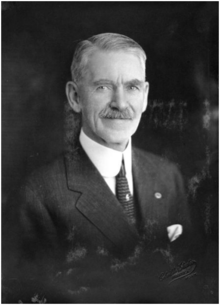| John Martin Keith | |
|---|---|
 | |
| 9th Mayor of Missoula | |
| In office May 4, 1891 – May 26, 1892 | |
| Preceded by | William Kennedy |
| Succeeded by | Frank G. Higgins |
| 12th Mayor of Missoula | |
| In office May 6, 1895 – May 2, 1897 | |
| Preceded by | Henry W. McLaughlin |
| Succeeded by | Frederick C. Webster |
| 18th Mayor of Missoula | |
| In office May 6, 1907 – May 2, 1909 | |
| Preceded by | Fred C. Morgan |
| Succeeded by | Andrew Logan |
| Personal details | |
| Born | (1859-06-05)June 5, 1859 New Brunswick, Canada |
| Died | July 8, 1929(1929-07-08) (aged 70) Missoula, Montana, United States |
| Spouse(s) | 1st - Harriet Beckwith (1890 - 1914) 2nd - R. A. Roderick (1918) |
| Profession | Clerk, Banker, Mayor |
John Martin Keith (June 5, 1859 – July 8, 1929) was a clerk and banker who was the only person to serve three nonconsecutive terms as mayor of Missoula, Montana.
Early and personal life
Keith was born in rural New Brunswick, British North America on June 5, 1859, where he was raised on a farm and educated in the local public school system. After graduating, Keith began work in the mercantile business for several years before moving to Missoula, Montana at the age of 22.
Missoula Mercantile
Keith arrived in Missoula in 1881 and began work as a clerk for Eddy, Hammond & Company, which was led by Keith's uncle Andrew B. Hammond, also of New Brunswick. In 1885, the store was incorporated as the Missoula Mercantile Company and was Montana's largest wholesale and retail store. Keith would be promoted to office manager before leaving in 1888.
Banking
Hammond and Edward L. Bonner had been investing in Christopher P. Higgins' Missoula National Bank, the oldest Bank Charter in Montana, since 1881. When Higgins was forced to resign as bank president in 1888, the next two presidents also resigned after five and six months respectively. Marcus Daly then became president with Hammond as vice president and Keith as Cashier.
Hammond became president of the bank in 1893 and renamed it the First National Bank of Missoula. Keith became vice president and the chief executive in charge of its affairs until 1910.
In February, 1910, Keith became the first president of the reorganized Missoula Trust & Savings Bank. He simultaneously served as president of the First National Bank at Plains and a member of the Hammond Lumber Company of San Francisco. Additionally, Keith held business interests in Spokane, Washington, was secretary of the South Missoula Land Company, vice president of the Missoula Real Estate Association, and was a member of the school board, library board, Mason, and the Elks.
Mayor
Keith was elected mayor three separate times without opposition on a citizens ticket, so as to be free from partisan bias. He was elected as Missoula's 9th mayor on May 4, 1891 and served for 12 months; he was elected as Missoula's 12th mayor on May 6, 1895 and served for 24 months; and he was elected as Missoula's 18th mayor on May 6, 1907 and served another 24 months.
As mayor, he attended the laying of the cornerstone of what was to become Montana's largest church, the St. Francis Xavier Church, along with Montana Governor Joseph Toole.
John M. Keith House

After his third term as mayor, Keith built his grand home on the south side of Missoula. His home, the John M. Keith House is on the National Register of Historic Places listings in Missoula County, Montana. Completed in 1910,
"The Prairie School style, promoted by architect Frank Lloyd Wright of Chicago, was intended to imitate the "rolling Midwestern prairie terrain." A low-pitched hipped roof and widely overhanging eaves augment the horizontal emphasis characteristic of the style, which is further enhanced by terra cotta tiles capping hip-roofed chimneys. A granite foundation and detailing add contrast to the walls of high-fired brown-rust brick. Much of the first-floor interior retains its original opulence, strongly influenced by the Craftsman style of the period, including exquisite woodwork, elegant paneling, pocket sliding doors, and a copper-clad entry hall fireplace. This distinctive home served as a private residence until the 1930s when it was purchased by the Sigma Chi fraternity."
— National Register of Historic Places
References
- ^ "Missoula Mayors Interred at the Missoula Cemetery". Missoula Cemetery. 2008. Archived from the original on October 31, 2015. Retrieved September 27, 2014.
- ^ Stout, Tom (1921). Montana, Its Story and Biography: A History of Aboriginal and Territorial Montana and Three Decades of Statehood, Under the Editorial Supervision of Tom Stout. American Historical Society. p. 469.
- Gordon, Greg (2014). When Money Grew on Trees: A.B. Hammond and the Age of the Timber Baron. University of Oklahoma Press. p. 93. ISBN 978-0806144474. Retrieved September 27, 2014.
- "Two Rivers History: A Confluence of Stories. "Andrew B. Hammond"". Archived from the original on August 4, 2012. Retrieved September 27, 2014.
- Kim Briggeman. "Chapter closes at old Missoula Mercantile building as Macy's to close". Missoula. Retrieved September 27, 2014.
- ^ "History of the First Interstate Bank of Missoula: A Timeline". First Interstate Bank. Archived from the original on September 28, 2014. Retrieved September 27, 2014.
- "Antique Letterheads ~ Banking and Finance". www.fortmissoula.org. Archived from the original on January 6, 2009.
| Missoula, Montana | |||||||||
|---|---|---|---|---|---|---|---|---|---|
| Suburbs |  | ||||||||
| Education |
| ||||||||
| Geography |
| ||||||||
| History |
| ||||||||
| Media |
| ||||||||
| Breweries | |||||||||
| Services |
| ||||||||
| Sports |
| ||||||||
| University of Montana | |||||||||